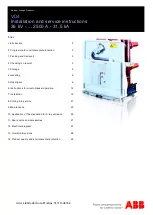
11
Interrupter/Operator Description
Modes of Operation - Mid-1991 and After
Pages 11-13 describe the operation of the mechanism
used beginning in approximately mid-1991.
This mechanism can be identified by observing the close
latch above the spring charging motor on the left side of
the circuit breaker. Refer to Figure 18. The close latch is
installed on the close shaft assembly 72, and includes a
hardened latch face. This face contacts a bearing which is
part of the close hatchet assembly 105. If the mechanism
has a close hatchet which bears directly on the close shaft,
refer to pages 13-15 for the description of your
mechanism.
Modes of Operation Discussion
Some maintenance procedures are more easily understood
when the operating mechanism modes of operation are
described in detail. The next few paragraphs explain the
five modes or status conditions (charging, closing, trip-
free, opening and rapid auto-reclosing) of the stored
energy operating mechanism.
Note:
All discussion of modes of operation assumes that
the reader is viewing the operator from the front, or from
the right hand side.
Spring Charging Mode
Figures 14a
and
15a
show several key components of the
operator mechanism in positions corresponding to the
circuit breaker open, with the closing springs discharged
(Figure 14a)
and charged (
Figure 15a)
.
Figure 16a
shows
portions of the operator mechanism that manually or elec-
trically charge the closing springs. The drive cam (20), the
closing spring crank arms
(Figure 19
) and spring condition
indicator cam (18) are directly keyed to the main cam shaft
(3). The main cam shaft rotates counterclockwise. The
closing springs are attached to the crank arms, and are
extended during the charging cycle.
Figure 16a
shows the ratchet wheel (15) which is free to
rotate about the main cam shaft (3). The ratchet wheel is
driven by either the charging motor or the manual charge
handle socket (52). When the springs are charged electri-
cally, the motor eccentric (100) introduces a rocking
motion into the drive plate (13). As this plate rocks back
and forth, the lower pawl (24-1) (which is connected to
the drive plate) imparts counterclockwise rotation of the
ratchet wheel (15), one tooth at a time. The upper pawl
(24-2) acts as a holding pawl during electrical charging.
When the springs are charged manually, up and down
pumping action of the spring charging handle in the
manual charge handle socket (52) causes the pawl plate
(11) to rock back and forth through the movement of the
Figure 14a:
Circuit Breaker Open—Closing Springs
Discharged.
Figure 15a:
Circuit Breaker Open—Closing Springs
Charged.




































